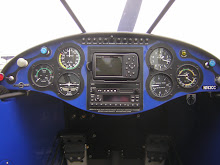As we waited for the lineman to fuel up the plane, I could see that my mother, who hates flying and heights, was becoming more and more apprehensive. Unfortunately, her butterflies managed to migrate and stir in my stomach as well. Prior to boarding the plane I made sure her headset fit comfortably, and that she had an opportunity to pose wearing her newest accessory.
After getting into the plane, which was a feat, I explained some basic safety considerations and made sure she was buckled in appropriately. To make her more comfortable, I made sure she was aware of all of the forces she would experience on take-off so that nothing would surprise her. After the run-up I received my clearance from both the tower and my mother. Having obtained both, we taxied out and began rolling down the runway. Shortly after the tail raised off of the ground, we effortlessly flew off of the runway. Amazed at how smooth everything was going, she sincerely asked if we were airborne. I jokingly responded that she needed to open her eyes and to see for herself. For anyone who has experienced a seamless transition from earth-to-air, they can appreciate my mother's reaction.
During our climb to 2000' AGL my mother inquired as to why we were going, 'so high'. I explained that it would be a little smoother and decrease our chance of CFIT. At cruising altitude, we hit a rough patch of air which made her uncomfortable, and me even more nervous. I could tell it was time to get her back on the ground before she made use of the sick sack.
After landing, with a forward-slip, which she did not seem to mind/notice, she hopped out of the plane with the biggest smile and most excitement in her voice that I had experienced in a long time. I don't know if she was more excited for being on the ground or for having flown with her son, 'the pilot'. I would like to believe it was the latter.
Now, it was my dad's turn. I provided the same safety briefing and explanation of the forces to be experienced, that I gave my mother. We taxied to the runway and passed from earth-to-air with another peaceful take-off. The morning was warm enough that we could leave the door and window of the cub open for our 20 minute flight around our town. We flew south and he photographed my house from the air and captured many other images during our flight.
Throughout both flights, the atmosphere is the airplane was quiet. For my mother's flight I attributed this to nerves. However, the quiescent mood during my father's flight relinquished within me, a genuine sense of accomplishment and pride that made his previous feelings for other achievements seem hokey and unnatural. This was a true father-son moment that could not be trespassed by the usual incredulity evoked by other pursuits. My ability to fly had become the one unequivocal accomplishment for which my father could not develop any doubt.
As we left the airport for early morning mass, I felt the relationship between myself and my parents had matured and been revived. For sometime, our familial bond seemed apathetic paralyzed. We had been going through the motions of being a family, without experiencing the emotions of a family. On this day, I witnessed aviation transcend flight and rekindle the bond of a family trying to understand one another.
Images to follow...










